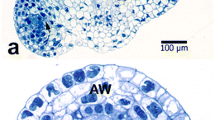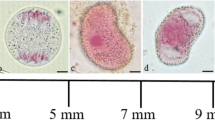Summary
The behavior of organelle nuclei during maturation of the male gametes ofLilium longiflorum andPelargonium zonale was examined by fluorescence microscopy after staining with 4′,6-diamidino-2-phenylindole (DAPI) and Southern hybridization. The organelle nuclei in both generative and vegetative cells inL. longiflorum were preferentially degraded during the maturation of the male gametes. In the mature pollen grains ofL. longiflorum, there were absolutely no organelle nuclei visible in the cytoplasm of the generative cells. In the vegetative cells, almost all the organelle nuclei were degraded. However, in contrast to the situation in generative cells, the last vestiges of organelle nuclei in vegetative cells did not disappear completely. They remained in evidence in the vegetative cells during germination of the pollen tubes. InP. zonale, however, no evidence of degradation of organelle nuclei was ever observed. As a result, a very large number of organelle nuclei remained in the sperm cells during maturation of the pollen grains. When the total DNA isolated from the pollen or pollen tubes was analyzed by Southern hybridization with a probe that contained therbc L gene, for detection of the plastid DNA and a probe that contained thecox I gene, for detection of the mitochondrial DNA, the same results were obtained. Therefore, the maternal inheritance of the organelle genes inL. longiflorum is caused by the degradation of the organelle DNA in the generative cells while the biparental inheritance of the organelle genes inP. zonale is the result of the preservation of the organelle DNA in the generative and sperm cells. To characterize the degradation of the organelle nuclei, nucleolytic activities in mature pollen were analyzed by an in situ assay on an SDS-DNA-gel after electrophoresis. The results revealed that a 40kDa Ca2+-dependent nuclease and a 23 kDa Zn2+ -dependent nuclease were present specifically among the pollen proteins ofL. longiflorum. By contrast, no nucleolytic activity was detected in a similar analysis of pollen proteins ofP. zonale.
Similar content being viewed by others
References
Correns C (1909) Vererbungsversuche mit blass(gelb)grünen und buntblättrigen Sippen beiMirabilis jalapa, Urtica pilulifera undLunaria annua. Z Indukt Abstamm Vererbungslehre 1: 291–329
Corriveau JL, Goff LJ, Coleman AW (1990) Plastid DNA is not detectable in the male gametes and pollen tubes of an angiosperm (Antirrhinum majus) that is maternal for plastid inheritance. Curr Genet 17: 439–444
Gillham NW, Boynton JE, Harris (1992) Transmission of plastid genes. In: Bogorad L, Vasil I (eds) Cell culture and somatic cell genetics of plants, vol 7. Academic Press, New York (in press)
Kadowaki K, Suzuki T, Kazama S, Oh-fuchi T, Sakamoto W (1989) Nucleotide sequence of the cytochrome oxidase subunit I gene from rice mitochondria. Nucleic Acids Res 17: 7519
Kuroiwa T (1991) The replication, differentiation and inheritance of plastids with emphasis on the concept of organelle nuclei. Int Rev Cytol 128: 1–62
—, Suzuki T (1980) An improved method for the demonstration of the in situ chloroplast nuclei in higher plants. Cell Struct Funct 5: 195–197
—, Kawano S, Nishibayashi S, Sato C (1982) Epifluorescent microscopic evidence for maternal inheritance of chloroplast DNA. Nature 298: 481–483
Miyamura S, Kuroiwa T, Nagata T (1987) Disappearance of plastid and mitochondrial nucleoids during the formation of generative cells of higher plants revealed by fluorescence microscopy. Protoplasma 141: 149–189
Nakamura S, Ogawa K, Kuroiwa T (1987) Survey of Ca2+-dependent nucleases in green plant. Plant Cell Physiol 28: 545–548
Nemoto Y, Kawano S, Nakamura S, Mita T, Nagata T, Kuroiwa T (1988) Studies on plastid-nuclei (nucleoids) inNicotiana tabacum L. I. Isolation of proplastid-nuclei from cultured cells and identification of proplastid-nuclear proteins. Plant Cell Physiol 29: 167–177
Ogawa K, Kuroiwa T (1985 a) Nuclease C polymorphism of calciumdependent nucleases inChlamydomonas reinhardtii. Plant Cell Physiol 26: 481–491
— — (1985 b) Destruction of chloroplast nuclei of the male gamete by calcium and nuclease C: in a cell model ofChlamydomonas reinhardtii. Plant Cell Physiol 26: 493–503
Rosenthal AL, Lacks SA (1977) Nuclease detection in SDS-poly-acrylamide gel electrophoresis. Anal Biochem 80: 76–90
Shimada H, Whittier RF, Hiratsuka J, Maeda Y, Hirai A, Sugiura M (1989) A physical map and clone bank of the rice (Oryza sativa) chloroplast genome. Plant Mol Biol Rep 7: 284–291
Sodmergen, Kawano S, Tano S, Kuroiwa T (1991) Degradation of chloroplast DNA in second leaves of rice (Oryza sativa) before leaf yellowing. Protoplasma 160: 89–98
Author information
Authors and Affiliations
Rights and permissions
About this article
Cite this article
Sodmergen, Suzuki, T., Kawano, S. et al. Behavior of organelle nuclei (nucleoids) in generative and vegetative cells during maturation of pollen inLilium longiflorum andPelargonium zonale . Protoplasma 168, 73–81 (1992). https://doi.org/10.1007/BF01332652
Received:
Accepted:
Issue Date:
DOI: https://doi.org/10.1007/BF01332652




